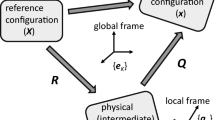Abstract
The potential of gelatin as a highly sensitive photoelastic material has long been known but seldom utilized. This paper describes a series of tests to show that body-force stress distributions can be conveniently found with gelatin models. Problems arising from the extreme variability of gelatin, including edge dehydration and bacterial attack which have plagued investigators in the past, may be overcome or even turned to advantage by careful control of the mixture and simultaneous calibration.
Previous work with gelatin in this country and abroad has been reviewed in order to indicate the available information on the instantaneous physical and optical properties. Data from the calibration test performed at Princeton were used to obtain both the instantaneous and the linearly viscoelastic creep behavior of the gelatin mixture chosen in terms of constant moduli which can be compared with other time-dependent, prototype materials. Apparatus and procedure for both calibration and model tests are outlined, and test results for one of the wedge-shaped gravity structures investigated are compared with analytic predictions.
Similar content being viewed by others
References
Richards, R., Jr., “Body-Force Stresses in Wedge-Shaped Gravity Structures,” Thesis presented to the Dept. of Civil Engrg. in partial fulfillment for the degree of Dr. of Philosophy, Princeton Univ. (May, 1964).
Raphael, J. M., “Dead Load Stress in Model Dams by Method of Integration,”Proc., Am. Soc. Civil Engrs.,87 (ST6),31–46 (Aug.,1961).
Sanks, R. L., “Photoelastic Analysis of Stress in a Dam Containing a Large Gallery,”Proc., Am. Soc. Civil Engrs.,81 (693 (May,1955). A405 E828 V 3
Filon, L. N. G., A Manual of Photoelasticity for Engineers, Cambridge Univ. Press (1936).
Moreno, C. A., Estudio de gelatinas para modelos fotoelásticos, Laboratorio Central de Ensayo de Materiales de Construcción, Pub. No. 58, Madrid (1958) [in Spanish].
Benito, C., and Moreno, A., Estudios fotoelásticos tridimensionales con modelos de gelatina, Lab. Central Ensayo de Mat. de Const.; Pub. No. 73, Madrid (1960) [in Spanish].
Osokina, A. H., “Solutions of Gelatin and Glycerin as a Material for Photoelastic Measurements,”Colloid Jnl.,19 (6) (1957) {cm[in Russian]}. A405 E828 V 3
Zandman, F., “Photoelasticity in the Soviet Union and Democratic Republics: A Brief Review,”Experimental mechanics,3 (2),19A-25A (1963).
Shichabalov, S. P. (Ed.), The Method of Polarized Light for Measurement of Stresses (Collection of papers presented in 1958 at the 1st Photoelastic Conf.), Pub. of the Univ. of Leningrad, section entitled “Geological Problems,” 290–320 (1960) [in Russian].
Farquharson, F. B., andHennes, R. G., “Gelatin Models for Photoelastic Analysis of Stress in Earth Masses,”Civil Engrg.,10 (4),211–214 (1940).
Crisp, J. D. C., “The Use of Gelatin Models in Structural Analysis,”Proc. (B), Inst. of Mech. Eng.,1B (12),580–604 (1952).
Tan, E., “Stability of Soil Slopes,”Proc., Am. Soc. Civil Engrs.,73,19–38 (1947).
Knappen, T. T., and Philippe, R. R., “Practical Soil Mechanics at Muskingum,” Reprinted from the Engineering News Record, Apr. 23, 1936, in the Proc., Int. Cont. on Soil Mech. and Found. Engineering, II, Appendix (1936).
Clevett, M. L., Jr., and Barry, J. D., “A Qualitative Gelatin Stress Analysis of the Effectiveness of Various Ground Anchoring Devices,” Tech. Rpt. QMRD-5, headquarters Quartermasters Rsch. and Development Command, Natick, Mass. (Oct. 1955).
Tarzaghi, K., “General Wedge Theory of Earth Pressure,”Trans., Am. Soc. Civil Engrs.,106,68–97 (1941).
Harroun, D.T., “Stability of Cohesive Earth Masses in Vertical Embankment,”Proc. Highway Rsch. Board,20,751–756 (1940).
Mindlin, R. D., “A Mathematical Theory of Photo-Viscoelasticity,” Jnl. Appl. Phys.,20 (Feb. 1949).
Frocht, M. M., Photoelasticity, 2 vols., John Wiley and Sons, New York (1941)and 1948).
Durelli, A. J., Phillips, E. A., andTsao, C. H., Inroduction to the Theoretical and Experimental Analysis of Stress and Strain, McGraw-Hill, New York (1958).
Freundenthal, A. M., Inelastic Behavior of Engineering Materials and Structures, John Wiley and Sons, New York (1950).
Nadai, A., Theory of Flow and Fracture of Solids, McGraw-Hill, New York (1950).
Williams, M. L., andArenz, R. J., “The Engineering Analysis of Linear Photoviscoelastic Materials,”Experimental mechanics,4 (9),248–262 (1964).
Mark, R., “A Dual-light Source for a Large Field Diffused-Light Polariscope,”Rev. Sci. Instr.,35 (4),521–522 (1964).
Author information
Authors and Affiliations
Rights and permissions
About this article
Cite this article
Richards, R., Mark, R. Gelatin models for photoelastic analysis of gravity structures. Experimental Mechanics 6, 30–38 (1966). https://doi.org/10.1007/BF02327111
Issue Date:
DOI: https://doi.org/10.1007/BF02327111




